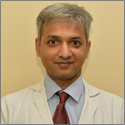Translate this page into:
New innovations in dry age-related macular degeneration treatment

*Corresponding author: Raja Narayanan, L.V. Prasad Eye Institute, Hyderabad, Telangana, India. dr_narayanan@hotmail.com
-
Received: ,
Accepted: ,
How to cite this article: Narayanan R. New innovations in dry age-related macular degeneration treatment. IHOPE J Ophthalmol. 2024;3:31. doi: 10.25259/IHOPEJO_14_2024
Age-related macular degeneration (AMD) is a leading cause of vision loss among people aged 50 and older, characterized by progressive damage to the macula – the central part of the retina responsible for sharp and detailed vision. AMD manifests in two forms: The “wet” form, marked by abnormal blood vessel growth under the retina, and the “dry” form, which involves the gradual thinning and degeneration of the macula. Globally, it is estimated that over 196 million people are affected by AMD, a number expected to rise to 288 million by 2040 due to an aging population. The financial burden of AMD treatment is staggering, with the cost of managing the disease – primarily through frequent anti-vascular endothelial growth factor (VEGF) injections for wet AMD – amounting to billions of dollars annually. This places a significant strain not only on healthcare systems but also on patients and their families. Despite dry AMD accounting for the majority of AMD cases, most treatment efforts have historically focused on the wet form. Anti-VEGF injections have become the cornerstone of wet AMD treatment, dominating retinal care and costing significant health-care dollars. However, no approved treatment currently exists that can reverse dry AMD or restore vision loss caused by the condition. In recent years, the advent of complement inhibitors such as Pegcetacoplan, a modified pegylated peptide targeting complement C3, and Avacincaptad pegol, a pegylated Ribonucleic acid aptamer inhibiting complement C5, has brought new hope. These Food and Drug Administration-approved drugs slow the progression of geographic atrophy associated with dry AMD; however, they require frequent intravitreal injections, raising concerns about their long-term feasibility and cost-effectiveness. Onetime gene therapies aimed at restoring complement system balance have the potential to revolutionize retinal disease management by offering a more sustainable and effective alternative. In addition, retinal pigment epithelium (RPE replacement therapy is emerging as a promising strategy for treating dry AMD. In this issue, Swathi Narasimhaiah et al.[1] provide an insightful review of the current research landscape in stem cell-based treatments for dry AMD. Among the noteworthy developments is Eyestem Research’s Eyecyte-RPE therapy, developed in collaboration with the L.V. Prasad Eye Institute, which is undergoing phase 1 clinical trials in India. The other centers in this early trial include the R.P. Centre for Ophthalmic Sciences, All India Institute of Medical Sciences, New Delhi, and Shri Ganapati Netralaya, Jalna, Maharashtra. Early results have shown the therapy to be safe, and ongoing trials aim to evaluate its efficacy. If successful and approved, this therapy could offer a viable alternative to the frequent intravitreal injections currently required for managing the disease. However, the challenges of surgical complexity and the need for immunosuppression could limit its scalability and applicability. The treatment landscape for dry AMD is at a pivotal moment, with innovative therapies finally receiving the attention and investment they deserve. The future holds immense promise for addressing the unmet needs of millions of individuals living with this debilitating condition.





